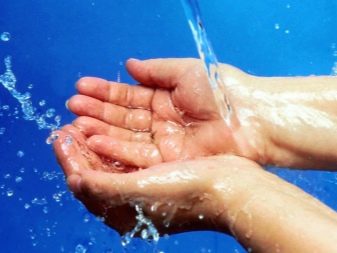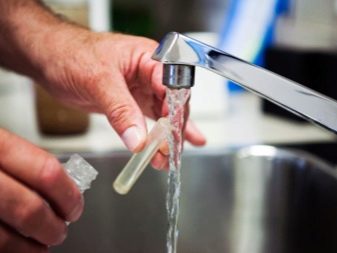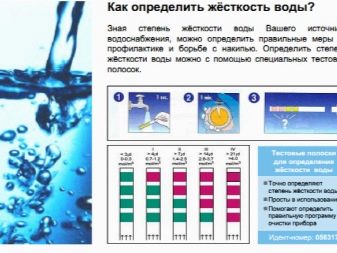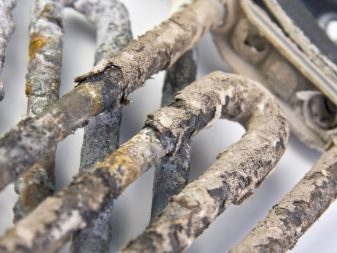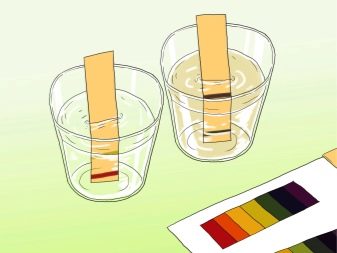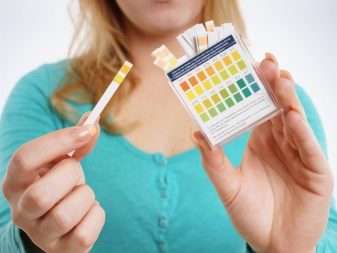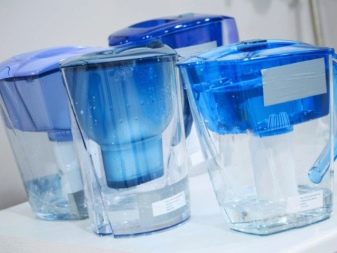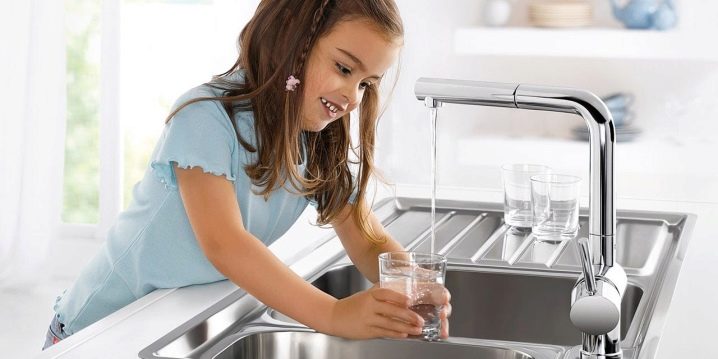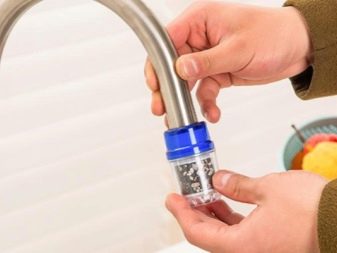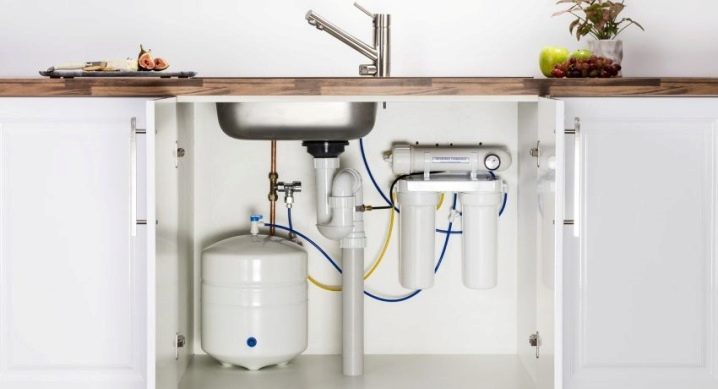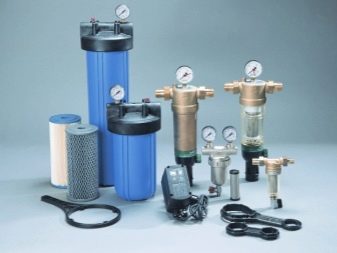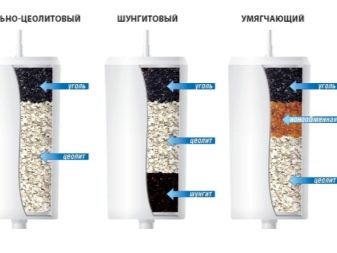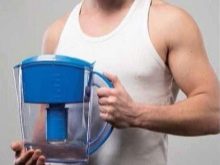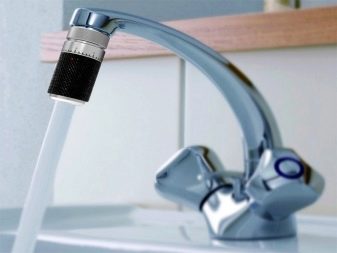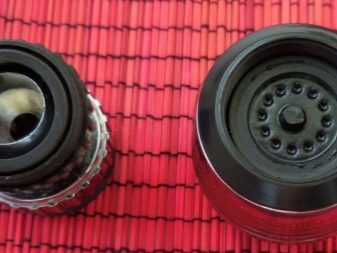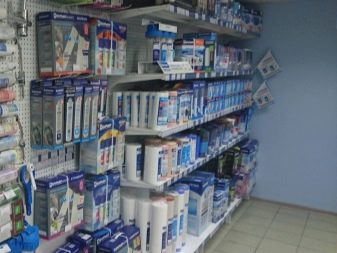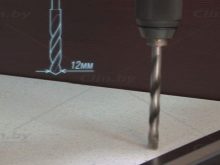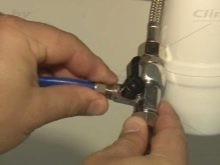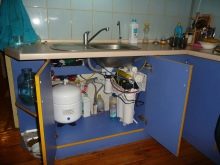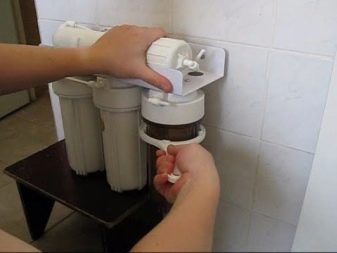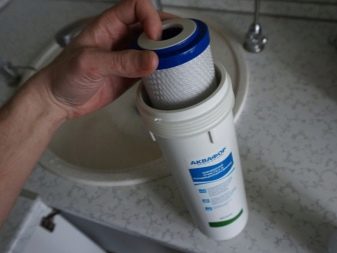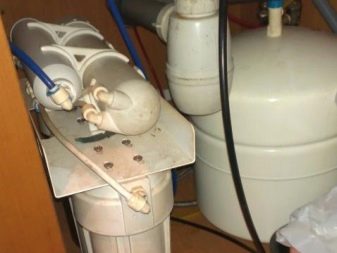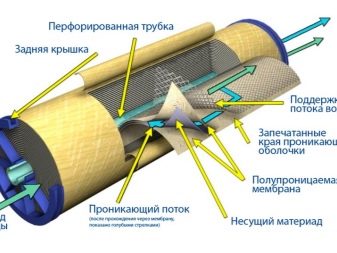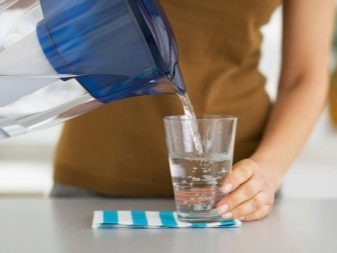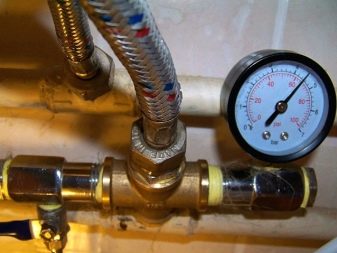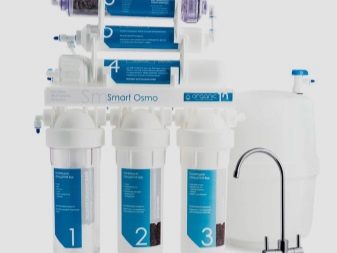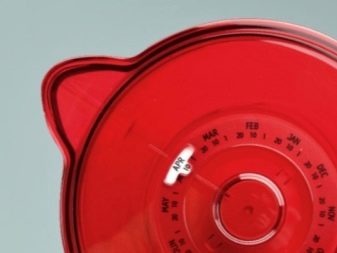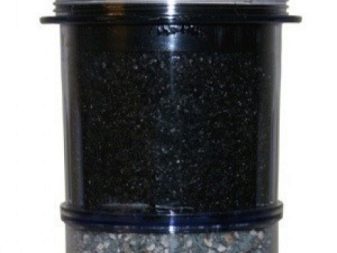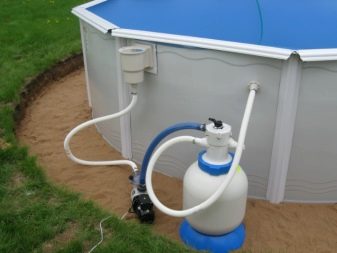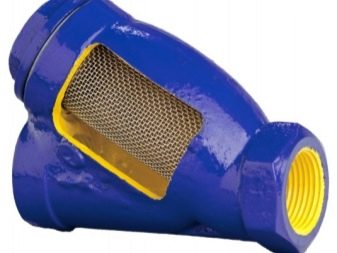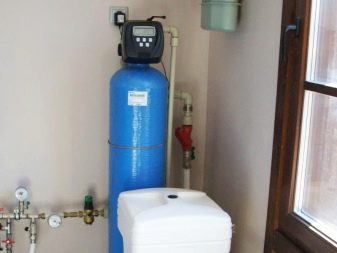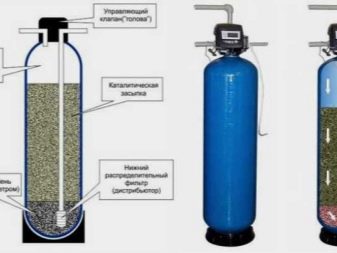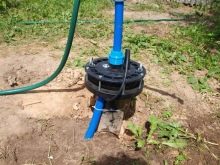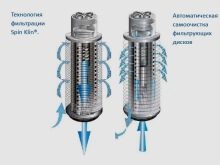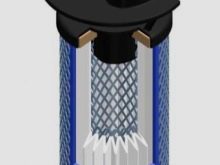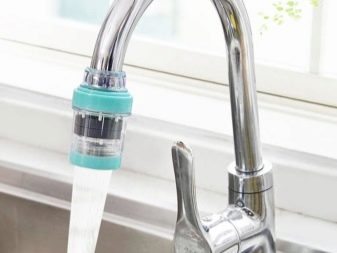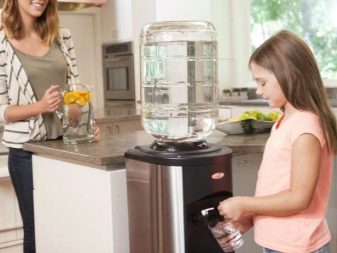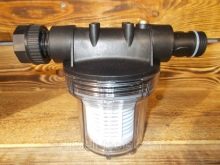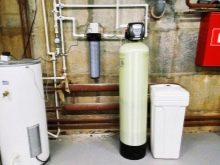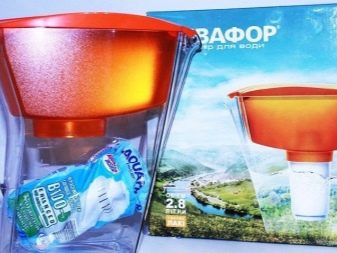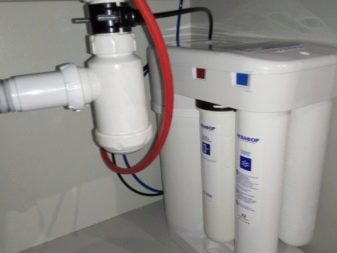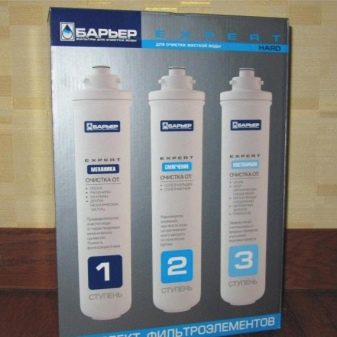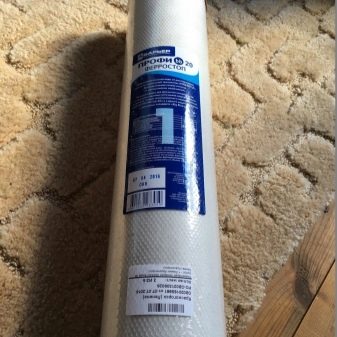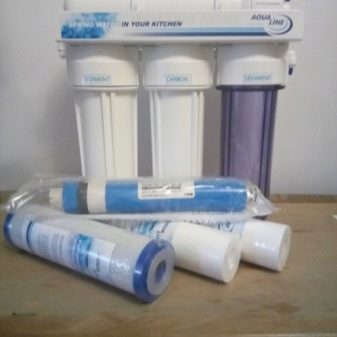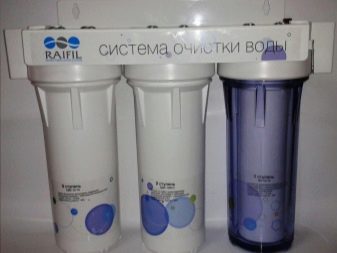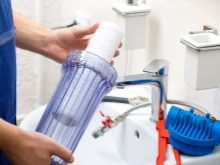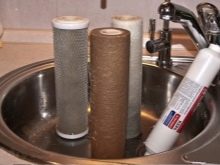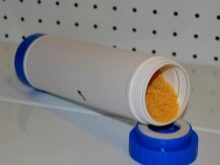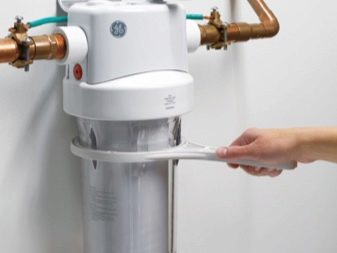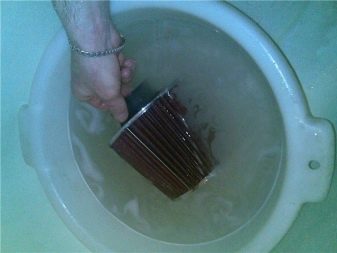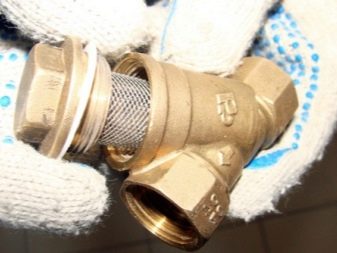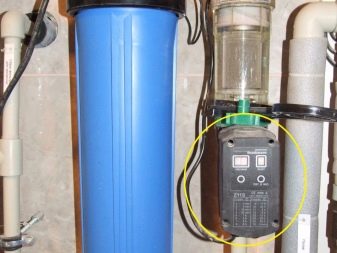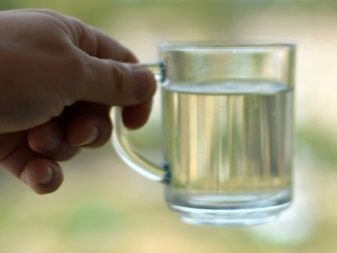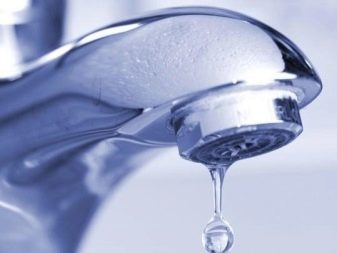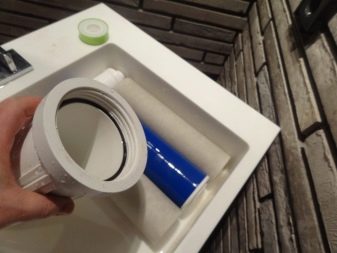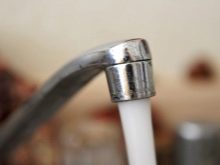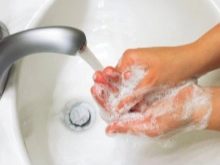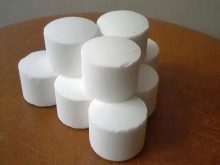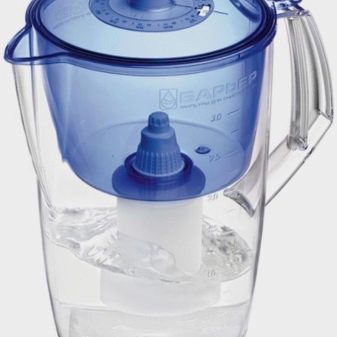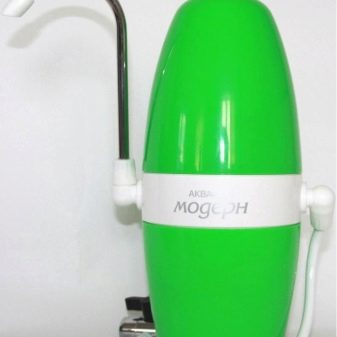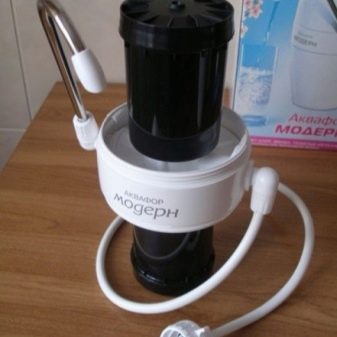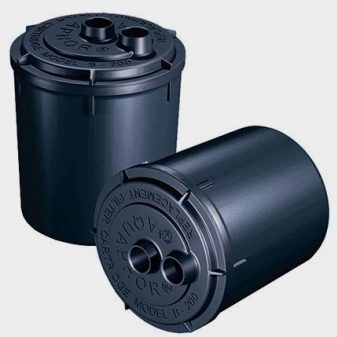Water filters: types and selection rules

Water is an element that is necessary in the life of each of us. It is also the main nutrient of any person. Fortunately, the amount of water that surrounds us is huge. But quality often has problems. Very often, tap or purchased drinking water is not at all suitable for drinking or cooking.
Not all people are concerned about the quality of the water they drink. But for those who are not indifferent we will write out in as much detail as possible what the dangers of some compounds are and what are the ways to clean the water at home.
Often, people “get stuck” at the stage of buying bottled drinking water, but it is obvious that it is much more expensive than installing a filter (even if not the cheapest). After all, with their help, you can get the right amount of clean water without spending a huge amount.
The need for purification
The water that flows from the tap is certainly suitable for washing dishes or washing, but you can hardly drink it without boiling. Chlorination, which is found in very many regions, forces the use of additional water purification mechanisms. To do this, apply different filters with different cost, quality and efficiency.
With water in wells or wells, the situation is a little better, but in this case there is a danger of catching a bacterial infection. This means that this water must be further purified using better filters. In order to find out the quality of water and determine the type of filter, first you need to conduct a fluid analysis by contacting specialists.
In tap water contains the so-called mechanical impurities: fine grains of sand, metal elements, rust, and a huge number of other components.They are many times reduce the service life of water taps, valves and household appliances. To deal with them in the residential premises establish multistage filtration systems.
Consider how some indicators of water quality can affect the taste of our food or even health.
Rigidity
Experts identify temporary water hardness and constant. Many of us know that boiling can cope with temporary rigidity. It solves the problem with stiffness, but it causes another problem - the appearance of sediment. Simply put, it is scum, which we constantly observe in teapots and other appliances. It can significantly reduce the duration of their work.
Hard water can cause the accumulation of salts in the human body, and then lead to diseases of the joints, the appearance of stones in the organs.
But it is also easy to see that soap does not wash so well in hard water, and laundry detergent leaves many times more.
In addition to special filtration systems, in the fight against calcium deposits on the walls of pipes sometimes use magnetic water purification. The best result can be achieved by combining these two cleaning methods.
Softness
It may seem strange, but too soft water is as unsafe for a person as it is too hard. The first one washes calcium and some beneficial bacteria out of the body. If a person uses such water from early childhood, then over time his bones can become very brittle.
If the hardness indicator of water is less than 0.5 mEq / L, it can flush out the accumulated sediments from the pipes for many years. This will cause an unpleasant taste and odor of water. But moderately softened water, on the contrary, will prolong the life of the boiler.
Iron
It is the increased iron content that paints our plumbing red-brown. Iron affects the taste of water and contributes to the accumulation of sediment in the pipes. And also it has a bad effect on the skin: it covers it with an insoluble film that causes irritation.
The iron content of water should not exceed 0.3 mEq / l. But if in the case of hardness and calcium content, the lack of a substance is just as undesirable as excess, then with iron it is not at all like that. It turns out, the less iron in the water, the more useful it will be. The body needs iron, but it can get enough of it from fruits and other foods.
If the indicator of iron content in water is artificially reduced to zero, then it will only benefit.
pH (pH)
Corrosion of pipes occurs if the pH is below 6.5.
From the foregoing it is important to remember that not all indicators of impurities in water should be reduced as much as possible, this is only relevant for iron. The content of other elements is important to keep within acceptable limits.
Varieties of devices
There are several types of water filters that are most popular today. In order to make it easier to make a choice, you need to familiarize yourself with the existing structures, their capabilities, characteristics and the principle of operation.
Design and features
Today there is a wide variety of filter designs.
Jug
The easiest filter. Looks like a plastic jug. Cleaning takes place with the help of replaceable cartridges installed in a special recess. This may be chemical, mechanical or biological treatment.
The internal material of the cartridges may be different, but cleaning occurs according to the same scheme: water is poured into the container above the cartridge, passes through it, and flows into the container of the jug, from which water can already be drunk.
Flow filtering
This method has several methods of implementation: desktop (nozzle on the crane) and the filter under the sink.
Filter nozzle on the crane (desktop)
Special clamps attach the device directly to the tap so that all the water passes through it.
Filter under the sink
This is commonly referred to as a stationary flow filter. The device is mounted under the sink and is equipped with a separate faucet, from which there is already purified water. Today it is the most popular method of cleaning tap water in residential premises.
Mainstream filtering
Such filters can be called built-in, as they are mounted in the water supply system itself. Often, the main filtration is used in houses without a central water supply, that is, water comes from a well or a well. But in multi-apartment buildings, the system is also used, especially if the quality and age of pipes leaves much to be desired. It is suitable for cleaning both hot and cold water.
The principle of operation and characteristics
The following are the main filtering substances which are found in cartridges for jugs.
- Activated carbon. It has a high level of adsorption and is able to remove many organic impurities from water.
- Zeolite. Purifies water from ammonia compounds. Being an excellent sorbent, it is able to absorb nitrates, oils and heavy metals.
- Shungite. The rock used to clean hard water. Shungite purifies water from chlorine, heavy metals, pesticides and some types of bacteria.
- Antibacterial additives.
Advantages and disadvantages
All types of filters have both positive qualities and disadvantages.
Jug
The main advantages of jug filters are that they take up little space and can be transported at will. They can easily fit on a table or in any corner of the kitchen. The biggest advantage is ease of use. To get clean drinking water you just need to pour it into the tank and wait a bit. And also attracts relatively low cost when compared with other varieties of filters.
The disadvantages include mediocre filtering quality. The result is directly related to the initial quality of water and the degree of its contamination. The need for frequent cassette changes and a small volume can also cause inconvenience.
Flow filtering, in turn, is divided into several types.
Filter nozzle on the crane (desktop)
Benefits:
- low cost;
- the ability to take a filter and apply in different places;
- can serve as an additional filter in a multistage filtering system;
- improves the taste of water.
Disadvantages:
- the filter will not cope with serious pollution;
- small volume of the absorbing substance;
- The flow-through cleaning system can only be installed in frost-free rooms.
Filter under the sink
Benefits:
- ease of use - cartridges are easy to replace, and the connection takes very little time;
- eliminates unpleasant odors and improves the taste of water;
- purifies water from carcinogens, chlorine and most mechanical impurities.
Disadvantages:
- the only drawback is the need to change the cleaning cartridges and their costs.
Mainstream filtering
Benefits:
- purify water from insoluble impurities (sand, silt);
- protect pipes and mixers from damage;
- the ability to install cartridges for different purposes.
Disadvantages:
- the need for regular replacement of cartridges, and to do this without recourse to specialists is almost impossible;
- filter installation can not do without professionals.
The range of models is quite extensive, so there may be problems with the choice. To acquire the necessary filter, it is necessary with the help of specialists to determine the bacteriological and chemical composition of water. Then, based on the results, choose the most efficient model.
So that water does not acquire an unpleasant taste or smell over time, it must pass through a filter made of environmentally friendly material. But it is also very important to get a warranty on the goods from the manufacturer.
Installation
Virtually any filter is easy to install yourself, guided by the instructions. The installation method is similar for similar models. The only difference is in the flasks and connecting hoses.
The first thing to do before starting work is to turn off the water. All knots and threaded connections are glued with a special hermetic tape.
When equipping the filter with a separate tap under the sink will need to be finalized. To install an additional valve (which will be directly connected to the filter), it is necessary to make a hole with a diameter of 12 mm. We'll have to intervene in the plumbing system, because the tap-tee is also installed with the filter.
There are several options: either cut out a part of the pipe, and install a tee in the hole, or attach it with a clamp.
When all the filter parts under the sink are installed, you can begin to connect them by flexible wiring. To flush the system, you need to drain up to twenty liters of water. After this procedure, you can fully use the filter.
In addition to installation, replacing the cartridge is also important.
The maximum time the cartridge can be used can be calculated based on the throughput index Often these numbers are shown on the first cartridges placed in the filter. For ordinary trunk household systems, this period is approximately 1.5-2 months. For larger models - up to 6 months.
Replacing the cartridge is easy to do yourself, if you follow the instructions:
- the first step is to close the water supply system again;
- under the filter any capacity is placed in which it is possible to collect the remains of water;
- the flask is unscrewed with a special key;
- then you need to get the old cartridge, replace it with another one;
- the flask is returned to its original position.
In order to prevent the use of untreated water, it is necessary to closely monitor the timely replacement of cassettes.
Economical types
Consider modern filters, which are by far the most economical.
Modular filtering
The system looks like a console with plastic flasks. The first stage of filtration is the retention of mineral and organic elements. Then the water goes through the modules, which, in turn, sorb, soften and remove iron. Impressive dimensions - the only item that can be attributed to the shortcomings of such models. The quality of cleaning is not perfect, but modular filtering is quite suitable for domestic needs.
For use in a private house is optimal choice of a modular system with membrane capacity. It maintains the desired pressure of the system and allows you to store a supply of clean water.
Reverse osmosis
This filtration system is the highest quality of all existing. Filters in its composition purify water from all the most common impurities. Also equipped with a membrane with the smallest pores. After passing through the membrane, the water enters a separate tank, and unhealthy impurities flow into the sewer channels.
The construction itself is rather complicated, but if desired and necessary it can be supplemented with some components: a pump (if the pressure is not high enough), a device for reducing pressure (if it is too high), a more spacious water tank, a mineralizer (for additional enrichment of water ), ultraviolet block (for additional sterilization).
The disadvantages of this system include volatility and the need to maintain constant pressure.
Ultrafilter
This is one of the varieties of the flow filter, which is mounted under the sink. It represents interconnected flow modules with different functions. Its main feature is the presence of a membrane with small pores, which is located in the cartridge of one of the modules.Having overcome all stages of filtration, at the end of purification water is passed through the membrane. Its openings are so tiny that they do not let in impurities and some types of viruses and bacteria. Salt balance after such purification is not saved.
The ultrafilter is able to disinfect ordinary water without changing its chemical composition. About the process of boiling, for example, this can not be said.
Even superficially examining the pros and cons of all filtration systems, it is safe to say that the pros outweigh. Perhaps the main disadvantage that makes people refuse to install is the high cost of some models. But you can start using the economical types like a jug, and then, if you feel a clear benefit, you can save up for something better and more expensive.
Criterias of choice
To select a filter that will be as efficient as possible, you need to take into account a number of criteria:
- average water consumption;
- required degree of purification;
- availability of space for installation;
- water pollution level;
- material opportunities.
Water consumption depends on the number of people living in the apartment. There is a daily rate of fluid for a person - 2 liters. To this can be added another 1 liter, given the preparation of tea, coffee, soups and other things. Knowing this approximate rate, one can calculate the average monthly water consumption for a family of three: 3x3x30 = 270 liters. Based on this figure, you can choose the desired water treatment system.
For example, for a cartridge in a jug, the average resource is approximately 270-300 liters. This means that a family of three will need to replace it every month.
Resource cartridges in reverse osmosis systems vary from 3 to 6 thousand liters. Resource sorption flow filters - from 3.5 to 8 thousand liters. We get the minimum term of use - 2500 l: 277 = 11 months. And the maximum - 8750 l: 277 = 30 months. Manufacturers do not advise using one cartridge system for more than 12 months.
But it also does not make sense to acquire a filter with a greater resource than the average consumption. A family of three is unlikely to spend 8750 liters per year.
Another very important point - the quality of tap water. After all, it may contain sand, rust, fungi, ammonia, salt and other impurities. It is better to find out about their availability before purchasing a filter.For this you need to collect a sample in a flask and contact the sanitary epidemiological station. A more expensive option is a private lab.
The next important indicator is water hardness. The exact value in milligrams equivalent per liter (mEq / l) can also be obtained in the laboratory. If the indicator is below 8, then the flow filter will cope with water purification. If the value is in the region of 10–12 mg-eq / l, installation of a reverse osmosis system, which has a special membrane in the configuration, will be required.
Another good reason to install a reverse osmosis filter is the presence of organic matter in water. The membrane does not allow bacteria, fungi or viruses to pass through it.
The choice of filter depends on the availability of funds. Here you can select the cheapest - a jug and the most expensive - a reverse osmosis system. It is important that all parts of the system are of high quality.
The first step before buying a filter with a reverse osmosis system should be to measure the pressure in the water supply system. If this figure is less than 2.8 atmospheres, the filter most likely will not work fully. The choice of a system that can process more daily water consumption is optimal, but it is also important to consider the performance of the system.
For rooms where water is used frequently and in large volumes, you should buy a filter with a capacity of 5 liters per hour.
The reverse osmosis system does not require replacing all filters at the same time. The prefilters, on average, last 6 months, the reverse osmosis membrane lasts 24 months, and the mineralizer volume is often designed for 1,000 liters, that is, for 6 months of use. The simplest systems consist of three filters, more complex (stepwise) - of 6.
The quality of the membrane protection directly depends on the quality of the standard set of parts, so they certainly should not be saved. The material of the tank under the water also has an important role. Plastic is ideal for installation in an apartment where there are no damaging external factors. The metal tank is more suitable for installation in the country, it will stand in front of external stimuli and will last for a long time.
There are several options for choosing a filter jug.
- Tank volume for liquid. Filters can be different in size, but do not recommend stagnation of water inside. It is better to use it immediately after cleaning. Families of 3-5 people often choose 2-3 liters models.From 6 people and more - jugs from four liters.
- Availability of cartridges for the purchased model. It is desirable that removable cassettes can be found in ordinary supermarkets, because you can simply not have time to call in a specialized store. It is also better to immediately pay attention to the price of these cartridges, because this amount will have to spend regularly for a long time.
- Module composition. With the type of sorbent will help determine the composition of water for cleaning.
- Additional details. In some models, on a special indicator, you can mark the date of replacement of the cartridge so that you do not need to constantly remember this. It is also desirable to have a counter, which indicates that it is time to change the module. Naturally, a filter with such a counter will be more expensive.
- Color and shape. With the choice of this parameter, there will be no problems, because there are quite a few varieties represented by any manufacturer.
But it is also important to understand that cartridges of one brand will not fit the filters of another brand. Each package or instruction shows a compatibility table in which these points are spelled out.
When choosing a carbon filter, it is important to pay attention to the brand of coal and the need to install a mechanical filter before the first one. One carbon filter is not able to cope with dangerous bacteria, and it will last a maximum of a couple of months.
Pool cleaning is done with sand filters. They serve for quite a long time, but they are not able to cope with substances dissolved in water.
For primary water treatment, stainless steel mesh or polyamide strainers are most often used.
Excess salt from the water will remove ion exchange filters. They will also help protect household electrical appliances from the appearance and accumulation of scale. These filters are also used in water boilers and boilers. But there is a drawback: due to the fact that virtually all the existing chemical elements remain in the filter, water completely loses its taste.
With the removal of iron and mist cope catalytic filter. More precisely, the material that is inserted into it. Its service life can vary from 60 days to several years. This option can not be called economical, because it requires additional valve installation for air separation.
Passing through reverse osmosis filters, water is literally purified at the level of molecules. This type of filter provides the highest quality cleaning (respectively - the most expensive). But there is a tangible flaw in them: water completely loses its taste, and the body does not receive the beneficial mineral salts that were contained in the water before the purification process.
Many owners of private homes organize drilling in their area for uninterrupted water supply. Of course, such water also needs to be filtered, especially if a high calcium content has been identified.
There are several filtration methods that will do well with water softening.
- Mechanical. Necessary for the retention of particles larger than 5 microns (micrometer). Shungite, coal and quartz sand are used for this. Filling filters are quite expensive and their dimensions are also impressive. They can be replaced by polypropylene cartridges that perform the same functions.
- Disk filters. If it is extremely accessible to explain the principle of operation of these devices, then they “glue” small particles of impurities into more visible elements that are easier to remove from water.
- Ultrafilter. The basis of their purification is special membranes with such small pores that neither lime nor organic molecules pass through them.
The filter nozzle is designed only for cleaning cold water. If hot water passes through it, then it will fall into the tank without changing its composition. Otherwise, some advantages - affordable price, mobility, ease of use and installation. Any model of the filter nozzle is equipped with a special adapter for attaching to a variety of taps. Among the features and selection criteria, there is a low filtration rate (up to two liters per minute) and a small resource (600-700 liters), but these figures are almost the same for all models of this type and may not be the main criterion.
If the filter nozzle, consisting of two plastic flasks with natural adsorbents, is placed next to the faucet, it can easily be regenerated and will last a very long time.
Dispenser - the so-called floor or desktop unit, which needs to be connected to the water supply. Such a filter works according to the jug scheme, but it also has a much larger volume. For large homes and large families, this option is indispensable.The capacity of dispensers can reach 6 liters of one-time loading. What is most unusual - such a filter can cool water and heat up to 95 degrees.
The dispenser connected to the network can perform the function of a cooler: there will always be clean hot water for making tea or coffee at hand. By the way, outwardly, it is also very similar to the cooler. The power of such a machine can reach 1000 watts.
There are models of dispensers, which, in addition to all the above functions, can still enrich water with oxygen. Such water will help fight overwork and stimulate mental activity. So far, such models are rarely available on the free market, but it can be assumed that in 5 years conditional they will gain due popularity.
A hit among all possible filters, of course, are the filters under the sink. This is a stationary version of the filter, which is placed under any sink (including ceramic) and just brought out as a separate tap. This filter does not take up much space in any configuration.
Possessing a fairly high speed of water purification (about two liters per minute), they do not need frequent replacement of filters.Capacity sizes can be completely different, and sometimes it is possible to develop an individual version. It’s hardly possible to install such a system on your own, so for installation it’s better to turn to a professional master.
Filters under the sink can be cumulative principle. The main difference in this case is the presence of a hydroaccumulator, in which purified water is accumulated. This can be convenient if there are frequent interruptions in the supply of tap water. With this filter will always be a small supply of clean water.
Prefilter - This device is needed in order to extend the life of the main filters. They are also used to protect from the salts of harmful impurities of conventional household appliances. Special water pressure sensors in the system (pressure gauges) allow monitoring and, if necessary, using a special valve to reset the pressure readings to the norm. Such a device can significantly extend the life of a washing machine or dishwasher.
Ion exchange filter - such models are quite expensive, and not everyone can afford it, but using such a filter you can achieve the maximum degree of water purification.The filter needs additional mineralization, as it demineralizes water in the cleaning process.
If even the water is contaminated with microflora and dangerous bacteria are present, you can safely drink it after filtering through a reverse osmosis system.
Rating of popular options
Perhaps the most famous domestic manufacturer of filters - "Aquaphor". The brand has established the production of all previously mentioned types of cleaners and has offers for any budget.
For cartridges for jugs "Aquaphor" you do not need to go to a specialty store, you can easily buy them in the supermarket. This is very practical, because they need to change quite often.
Only Aquafor jugs produce 3 types. And in the flow-through filters, the filler is the special invention of the company - Aqualen. This substance is a peculiar variation of the polypropylene filter. There are models of flow filters with collapsible and non-collapsible cartridges.
"Aquaphor" is among the manufacturers who manufacture the cleaning nozzle on the faucet.
The second most popular domestic brand - "Barrier", which has a wider selection of flow systems. There are even models made under water with certain features: with Ferrostop technology for water with high iron content or with a special softening cartridge for hard water.
Reverse osmosis systems “Barrier” began to be manufactured relatively recently. The main difference from Aquaphor is the use of a Russian-made membrane. There are other features and unique finds, such as a baby filter or a bath filter.
Aqualine - manufacturer of filters from Taiwan. Their most popular models are flow filters and reverse osmosis systems. Due to the high quality and relatively low price, the firm was entrenched among the world's leading manufacturers of filtration systems. For them, a Korean-made membrane is used.
One of the features that distinguishes Aqualine filters from others is the transparent plastic filter flask in reverse osmosis models. This makes use more convenient, because it is clearly seen through the transparent walls that it is time to replace the filler in the cartridges. Thanks to a special system, the flasks are easy to install, and it is also possible to install a mineralizer.
Flasks are made with a rubber seal that protects against any leakage.
Raifil - Manufacturer, whose plant is located in Taiwan, and the main cooperation is conducted by South Korea.
The company specializes in the production of large industrial filtering machines with reverse osmosis system. In their case, used membranes of American and Korean production. The advantages of their models over others are high-quality plastic for flasks, stiffening ribs on flasks, and a special ribbon in the configuration for stronger fixation. Pumps have improved performance.
For ease of mounting and additional protection from external influences, the flasks are located on a special metal plate.
Operation Tips
The purchase and installation of a drinking water filter does not end there, because any filter needs regular maintenance. Many models are made so that permanent procedures could be done by yourself without recourse to the master.
There is a list of these procedures:
- cartridge replacement, necessary for any model after a certain amount of water has been consumed;
- replacement of the membrane, the average interval between procedures - one and a half years;
- chemical washing of the membrane;
- valve flushing;
- replacement of fillers in cartridges;
- restoration of the softener (if any).
But such a procedure as the installation of an ultraviolet cleaner can only be done by a professional master.
All household filter housings need flushing. The first step is washing with soapy water and a sponge (rag), the second is rinsing with clean water. Some cartridges can be cleaned, and some can only be replaced with a new one. Filters that accumulate primarily mechanical impurities are easy to clean.
A number of models are equipped with a mechanism that independently drains accumulated impurities into the drainage. To bring it into action, you need to open the valve on the body. Impurities will wash off in a powerful stream. If such a valve is not provided in the assembly, then you will need to disassemble the filter, take out the module and wash it yourself, disinfect it and clean it. It is often washed in citric acid to get rid of limescale.
At the end of all procedures, the filter must be reassembled, making sure that there are no leaks.
The method of cleaning the cartridge depends on its type.
Consider the most common:
- mesh - the plastic or metal mesh is cleaned by washing the cartridge with soapy water;
- polypropylene - such models are not cleaned or washed, but simply replaced as littered;
- coal - they need to either be completely changed, or fall asleep again;
- ion exchange - are replaced with the use;
- aragon - the method of their recovery is prescribed in the instructions for each individual model, mainly for this purpose they use lemon or soda solution; exception - Aragon from the BIO series, which must be replaced immediately after the resource is exhausted;
- membrane - they are also replaced as the service life expires, but it can be extended by properly cleaning the case; because biological formations accumulated over time can get on the membrane and clog it.
Water systems in cottages often have an automatic flushing function, that is, the filter is disinfected from the inside. The main task of each consumer is not so much in cleaning or washing the filter, but in doing it regularly and as often as prescribed by the manufacturer. If you do not follow the usage period and the resource of consumed water, then its quality will simply become the same as before cleaning. Because the filter simply ceases to perform its direct function.Regularity is especially important for pitchers, reverse osmosis systems and three-stage filtration systems.
If you do not change the filter for a long time, you can notice a gradual change in the taste of water.
If the water during the cleaning of the filter barely drips, be sure to find out the reason for this. It may be an unscrupulous water supplier, the failure of one of the water supply pumps, or the sedimentary stage stopped flowing and should be rinsed. But also such a symptom may be the result of regular violations of the rules of operation. In the latter case, repair work cannot be done.
It is important to understand a simple fact: the more water is consumed, the faster the consumable consumables for it run out. Therefore, their cost should be paid attention to when buying a filter and at least approximately calculate how much the annual maintenance of the system will cost.
Heavy fillers in the filters must be regularly washed and mixed. After all, the accumulated pollution can simply glue the elements of the filter, which will make the cleaning process almost useless.
Here are some universal tips for owners of water purification filters.
- If the water quality has deteriorated markedly, you do not have to rush to call the masters; for starters, you can regenerate the filler materials with good water pressure. The softener should contain a large amount of salt tablets, it is allowed to add citric acid. At the end of the regeneration process, you need to drain a small amount of water through the filters, and then try washing your hands with soap. When the softener soap almost will not wash off.
- With an iron remover, everything is a little more complicated, because if it is used for a long time, it simply turns into a stone (it can also become a polluter) and needs to be replaced.
- You should never save on salt pills. Poorly purified salt will stain the filler, and if it is poorly compressed, its consumption will be much higher, and the regeneration mode will be broken.
Usage Reviews
According to reviews on the domestic filter “Barrier”, when using the filter in the form of a jug at home, I didn’t like the fact that water periodically stagnated in it.Positive reviews say this is a very convenient, compact and pretty filter. Users mark a very convenient element - a slider on the lid of the jug, which you can scroll through and set the date of the last cartridge replacement.
A lot of reviews about the filter "Aquaphor Modern".
- It looks pretty cheap - a simple flask with a tap. For some users, it is important that the filter looks stylish and fits well into the interior of the kitchen.
- Water after cleaning may acquire a metallic taste. According to reviews, on the second week of using the cartridge taste disappears.
- Takes up little space. In any kitchen, even the most compact, this filter will fit. If necessary, you can keep it on the refrigerator.
Many note the convenience of the nozzle, with which you can easily draw water into the filter: you just need to turn the faucet with cold water. Users note that the filter is quite expensive, so the expectations from the very beginning are appropriate. Plus, the total cost was added for the work of the wizard for the installation of this filter and the cost of replaceable cartridges.
And also there are a couple of important nuances that users are talking about: stones need to be washed every few days, about once a week to completely change them, the stones give up all their properties, and over time they simply do not absorb harmful impurities from the water.
How to choose a filter for water, see the next video.

